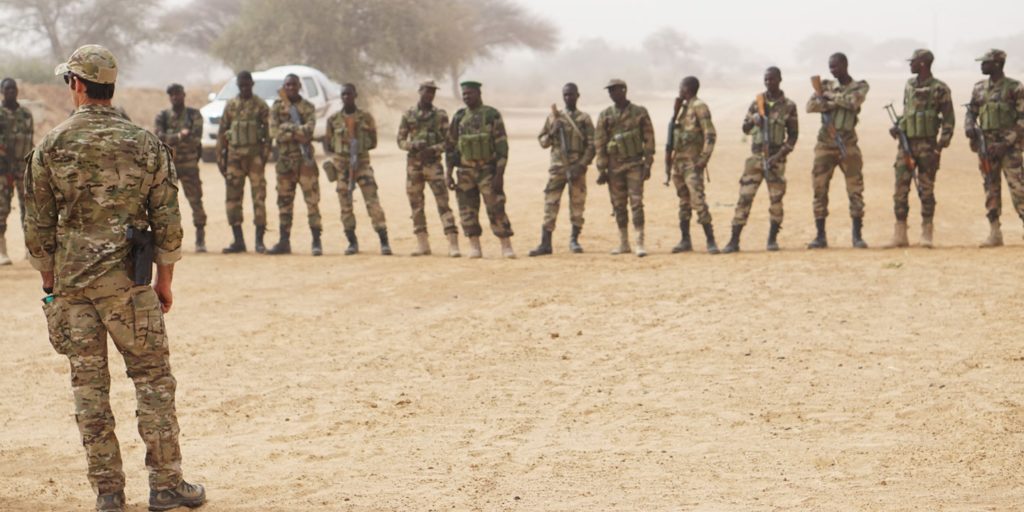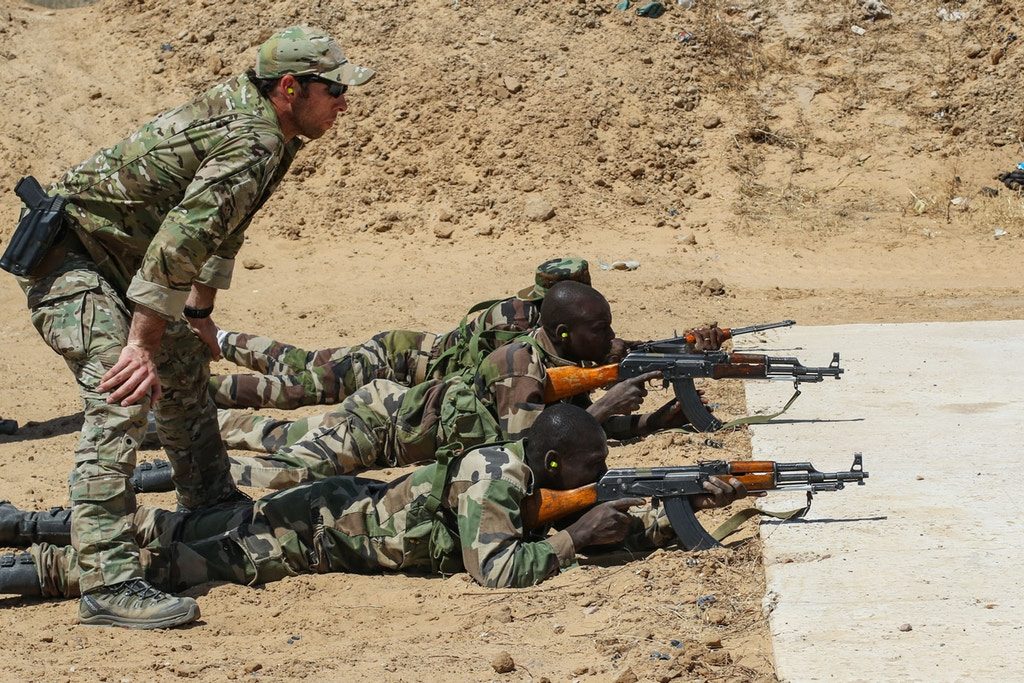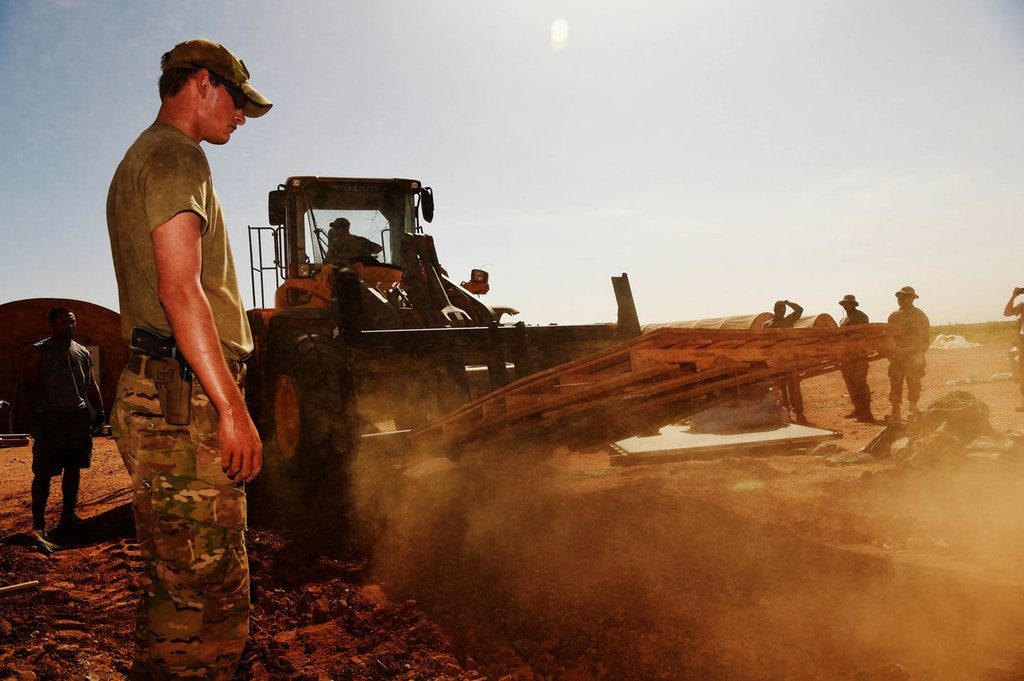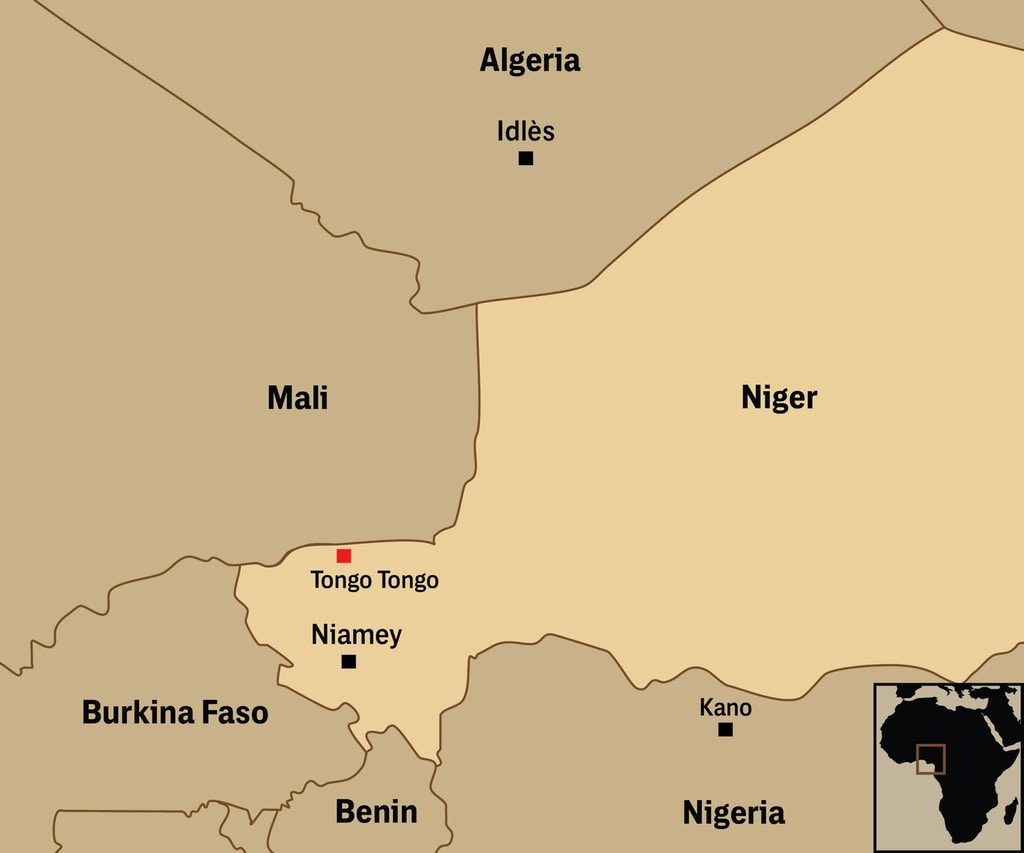It’s Not Just Niger — U.S. Military Activity Is a “Recruiting Tool” for Terror Groups Across West Africa
AFRICA, 6 Nov 2017

A U.S. Army Special Forces weapons sergeant speaks to a group of Nigerien soldiers during Exercise Flintlock 2017 in Diffa, Niger, on March 11, 2017. Photo: Spc. Zayid Ballesteros/U.S. Africa Command
26 Oct 2017 – The mission never made the front page of the New York Times or the Washington Post. It wasn’t covered on CNN or Fox News. Neither the White House chief of staff, the chair of the Joint Chiefs of Staff, nor the president ever addressed it in a press briefing. But from mid-January to late March 2013, Green Berets from the 10th Special Forces Group deployed to the impoverished West African nation of Niger. Working alongside local forces, they trained in desert mobility, the use of heavy weapons, and methods of deliberate attack.
On May 15 of that year, another contingent of Special Forces soldiers arrived in Niger. For nearly two months, they also trained with local troops, focusing on similar combat skills with an emphasis on missions in remote areas. From the beginning of August until mid-September, yet another group of Green Berets traveled to the hot, arid country for training, concentrating on desert operations, heavy weapons employment, intelligence analysis, and other martial matters, according to Pentagon documents obtained by The Intercept via the Freedom of Information Act.
One constant of all of these counterterrorism missions, which were carried out by small teams of elite U.S. troops operating alongside Nigerien forces, was a concentration on reconnaissance. Until recently, such missions were conducted without notice or media scrutiny. Americans were involved in firefights, but the operations were kept quiet. When special operators died in Africa, it was due to an accident or after a night of partying. Americans were rarely killed in combat.
Four years later, on October 3, 12 Green Berets undertook a “reconnaissance mission” alongside 30 Nigerien soldiers near the village of Tongo Tongo, about 85 kilometers north of the capital city of Niamey, according to the chair of the Joint Chiefs of Staff, Gen. Joseph Dunford. (Some reports indicate it had morphed into a “kill-or-capture” mission aimed at a high-value target with ties to both Al Qaeda and the Islamic State.)
The next day, as the joint force was moving south “en route to their operating base, the patrol came under attack from approximately 50 enemy using small-arms fire, rocket-propelled grenades, and technical vehicles,” explained Dunford. Four Green Berets were killed and two wounded in the ambush, which also claimed the lives of five Nigerien soldiers.
In truth, U.S. forces are already deployed all across Africa by the thousands. Around 6,000 troops are on the continent, conducting 3,500 exercises, programs, and engagements each year – almost 10 missions each day — from Cameroon to Somalia, Djibouti to Libya. More than 800 of these forces, Pentagon spokesperson Maj. Audricia Harris told The Intercept, are deployed to Niger. This is up from approximately 100 troops sent in 2013 to carry out drone reconnaissance missions, making the hardscrabble country, wedged between seven nations, including Mali, Libya, Nigeria, and Chad, the largest concentration of U.S. military forces in West Africa.
“The rapid, largely unrecognized increase in U.S. troops in Niger is part of the large expansion of the U.S. military footprint in Africa,” says William Hartung, director of the Arms and Security Project at the Center for International Policy. “This expansion is long overdue for congressional scrutiny and public discussion.” U.S. efforts, primarily focused on training allies and proxies, are flawed, often ineffective, and can have destabilizing effects on countries that military operations are meant to strengthen, according to experts. Cast as benign training operations, they can lead to unforeseen consequences and dangerous blowback. “While the Pentagon likes to downplay the military aspects of these missions, in a number of instances, they have involved acts of war that risk getting the U.S. involved in broader conflicts, even as they have had little impact on the spread of terrorism,” Hartung notes.
While 800-plus troops are in Niger today, many more soldiers rotated through the country as U.S. forces have been, according to Dunford, carrying out intermittent missions for 20 years.
In 2002, the U.S. launched a counterterrorism program — known as the Pan Sahel Initiative, which later became the Trans-Sahara Counterterrorism Partnership — to assist the militaries of Chad, Mali, Mauritania, and Niger before expanding to include six additional nations nearby. Between 2009 and 2013 alone, the U.S. allocated $288 million in TSCTP funding, according to a 2014 report by the Government Accountability Office. Niger netted more than $30 million. Neighboring Mali held the top spot at $40.6 million.
These programs saw U.S. troops deployed again and again to carry out advisory and “train and equip missions,” as well as mentorship programs designed to increase local anti-terrorism capabilities, encourage local populations to cooperate with military forces, and build the military capacity of those soldiers to enable them to “Find, Fix, and Finish” militant groups, according to a 2014 State Department analysis of the TSCTP obtained by The Intercept, via the FOIA.

A U.S. Army Special Forces weapons sergeant observes a Niger Army soldier during marksmanship training as part of Exercise Flintlock 2017 in Diffa, Niger, on Feb. 28, 2017. Photo: Sgt. 1st Class Christopher Klutts/U.S. Africa Command
By 2011, U.S. Africa Command’s efforts in Niger and Mali included a host of training programs, such as the employment of Civil-Military Support Elements, Joint Planning and Assistance Teams, and Senior Leader Engagements, as well as Mobile Training Teams – a program in which U.S. troops provide instruction on using and maintaining weapons and other equipment.
The United States also employed a host of other episodic training programs, including the African Crisis Response Initiative, African Contingency Operations Training and Assistance, International Military Education and Training, Counterterrorism Fellowship Program, Global Peace Operations Initiative, and Joint Combined Exchange Training. Most of the military instruction was carried out by Green Berets. In a Naval Postgraduate School thesis, Maj. Simon Powelson, who was was involved in 10th Special Forces Group training operations, wrote, “These efforts did not result in a measurable increase in the overall effectiveness of the Malian army (or of individual units for that matter). Training that was episodically provided rarely diffused or even took hold.”
Similar efforts were undertaken in Niger, where, since 2006, the Defense Department has provided approximately $165 million in counterterrorism equipment and training, the second-highest total in all of Africa, according to the Congressional Research Service. But the results have been similar to those in Mali, says Michael Shurkin, a senior political scientist at the RAND Corporation, who has written extensively on both countries. “What U.S. troops were doing in Niger is pretty much what we’ve been doing in the region since 2003,” he said. “Everything we’ve been doing certainly hasn’t amounted to much because everything has gotten worse. None of it is really effective.”
Rebecca Zimmerman, a national security and foreign policy researcher at the RAND Corporation, warns of grave consequences when poor, fragile states are inundated with counterterrorism training and equipment. Such efforts can, she says, create a culture of dependency, increase corruption, and create power imbalances between the armed forces and often weak civilian governments. “In countries where there is inadequate civilian control of the military, this is a particular risk,” she said.
In fact, TSCTP member-state Chad saw attempted coups in 2006 and 2013; members of Mauritania’s military overthrew the government in 2005 and again in 2008; a military junta overthrew Niger’s president in 2010; and a U.S.-trained military officer, Amadou Sanogo, toppled the democratically elected president of Mali in 2012. “The role of a U.S.-trained officer in overthrowing the government of Mali is yet another case of arms and training programs backfiring and creating a more chaotic environment in which terrorist organizations can grow,” Hartung told The Intercept.
Schooled in the U.S. through a variety of military training initiatives, Sanogo and his clique were upset at his government’s inadequate response to an insurgency in Mali’s north. As the U.S.-backed war in Libya was helping to topple Moammar Gadhafi, nomadic Tuareg fighters in the Libyan dictator’s service looted his regime’s weapons caches, returned to their native Mali, and began to carve out a homeland.
Soon, however, Islamist militants pushed out the Tuaregs, took over much of the north, instituted a harsh brand of Sharia law, and created a humanitarian crisis that displaced hundreds of thousands. But Sanogo’s junta proved no more militarily effective than the government he overthrew. “The coup made everything a lot worse. The coup didn’t yield a strongman. The coup yielded nothing, just vacancy,” said Shurkin. In 2013, with Islamist militants besting Sanogo’s military, a U.S.-backed French and multinational regional force intervened to prevent a takeover of the country. Since then, Mali has been mired in an intractable insurgency and militant groups have thrived in the vacuum.
In fact, the entire region, relatively free of transnational terror threats in 2001, is now beset by a host of militant groups. They include, according to the Defense Department’s Africa Center for Strategic Studies, the local branch of Al Qaeda in the Islamic Maghreb, Al Mourabitoun, Ansar Dine, and the Macina Liberation Front, which now all operate under the mantle of Jama’at Nusrat al-Islam wal-Muslimin, as well as Boko Haram, the Movement for Unity and Jihad in West Africa, Ansaroul Islam, and the Islamic State in West Africa (or Wil?yat Gharb Ifr?q?yyah). And it was reportedly members of a newer group operating out of Mali’s restive regions, the Islamic State in the Greater Sahara, that crossed the border into Niger and carried out the attack that killed the four Green Berets.
“While the roots of terrorism are complex,” observed Hartung, “it is fair to say that the larger U.S. military presence has, at a minimum, served as a recruiting tool for the growing number of terrorist groups operating in West Africa.”
With the French military trapped in what appears to be an interminable counterinsurgency campaign in Mali, the U.S. has increasingly stepped up its presence in neighboring Niger, even in the wake of the recent ambush. “U.S. troops continue carrying out a variety of operations in Niger, including continued advise and assist missions,” says Defense Department spokesperson Lt. Col. Michelle Baldanza.

Airmen from the 724th Expeditionary Air Base Squadron and soldiers from the 411th Military Police Company, 89th MP Brigade, 1st Platoon, tear up wooden pallets as they move to a new location, Sept. 11, 2017, at Air Base 201 in Agadez, Niger. Photo: Staff Sgt. Joshua R. M. Dewberry/435th Air Expeditionary Wing
For its part, AFRICOM says its forces are “supporting the U.S. Embassy” in the country’s capital, Niamey. Troops are also stationed at Base Aerienne 201 (Airbase 201), outside the city of Agadez, a transit hub at the edge of the Sahara in Central Niger, “supporting ISR,” or intelligence, surveillance, and reconnaissance operations, according to Baldanza. AFRICOM calls Base Aerienne 201 “a temporary, expeditionary contingency support location,” but The Intercept previously revealed it is, in fact, a $100 million drone base in the making.
According to declassified secret documents from 2015, obtained via the Freedom of Information Act, Niger was the “only country in NW [northwest] Africa willing to allow basing of MQ-9s,” the larger, potentially more lethal cousins of the Predator drone. The documents went on to note that Niger’s president “expressed willingness to support armed RPAs,” or remotely piloted aircraft, the military euphemism for drones. New reports indicate the United States is now pressing Niger to allow the deployment of such drones in order to carry out lethal strikes there.
“RPA presence in NW Africa supports operations against seven [Department of State]-designated foreign terrorist organizations. Moving operations to Agadez aligns persistent ISR to current and emerging threats over Niger and Chad … and extends range to cover Libya and Nigeria,” say the 2015 files, which also call Agadez the “top MILCON [military construction] project for USAFRICOM.” That construction continues to this day.
The Pentagon refused to comment on the size of troop levels at Niger’s bases, citing security concerns. Some indication can, however, be gleaned from an Air Force contract awarded last month for 80 Quonset hut-shaped prefab tent structures at Air Base 201 — the type of structures long ubiquitous at bases in Iraq and Afghanistan, providing about 800 separate rooms.
AFRICOM cryptically adds that U.S. personnel are also “stationed in the country for other temporary duties and operations.” Recent contracting documents from the Defense Logistics Agency reference a Joint Special Operations Air Component and indicate ongoing needs for diesel and jet fuel at Niger’s Base Aérienne 101, a longtime U.S. drone outpost, attached to Diori Hamani International Airport in the country’s capital, Niamey; it is used for regional ISR missions. The U.S. is also considering beefing up Air Base 101 by adding defensive fighting positions — towers to provide blast and ballistic protection with gun ports that allow troops to return fire — according to Air Force contracting documents issued this past summer.
Contracting documents also indicate future requirements for fuel at a number of other Nigerien locales, including Tahoua and Ouallam, as well as the need for 4,400 gallons per month of gasoline, 1,100 gallons per month of diesel fuel, and 6,000 gallons of aviation turbine fuel every 90 days to be delivered to a “military installation” in Dirkou. A DLA document from this summer also shows potential interest in deliveries of unleaded gasoline and diesel fuel to the village of Tillia.
The expansion and hardening of facilities at Agadez and Niamey, and the contracts indicating a need for fuel at other remote locations, suggests an expanding presence in Niger. So, too, do comments reportedly made by U.S. Secretary of Defense James Mattis to two senior members of the Senate Armed Services Committee last week. “You’re going to see more actions in Africa, not less,” said Sen. Lindsey Graham after his briefing from Mattis. “You’re going to see more aggression by the United States toward our enemies, not less.”
Shurkin finds Graham’s statements troublesome. “When I hear Lindsey Graham I get very worried because he’s a hawk, Shurkin said. “His answer always is more. I’m worried because I think that means dialing up everything that we’ve been doing. More money, more troops, more training programs, more Green Berets, more helicopter support, a bigger footprint.”
“Simply throwing more money at the existing programs and doing what we’ve been doing — but just simply more of it — strikes me as a really bad idea,” Shurkin added. “At the very least, we’re going to waste a lot of money. And we can definitely make things worse.”
_____________________________________________
Related:
- U.S. Military Is Building a $100 Million Drone Base in Africa
- The U.S. Extends Its Drone War Deeper Into Africa with Secretive Base
- The U.S. Will Invade West Africa in 2023 after an Attack in New York — According to Pentagon War Game
 Nick Turse is an award-winning investigative journalist and a contributing writer for The Intercept, reporting on national security and foreign policy. He is the author, most recently, of Next Time They’ll Come to Count the Dead, War and Survival in South Sudan, as well as Tomorrow’s Battlefield: U.S. Proxy Wars and Secret Ops in Africa, and Kill Anything That Moves: The Real American War in Vietnam. He has written for The New York Times, Los Angeles Times, San Francisco Chronicle, The Nation, and Village Voice, among other publications. He has received a Ridenhour Prize for Investigative Reporting, a James Aronson Award for Social Justice Journalism, and a Guggenheim Fellowship. Turse is a fellow at The Nation Institute and the managing editor of tomdispatch.com. Twitter: @nickturse – Securedrop
Nick Turse is an award-winning investigative journalist and a contributing writer for The Intercept, reporting on national security and foreign policy. He is the author, most recently, of Next Time They’ll Come to Count the Dead, War and Survival in South Sudan, as well as Tomorrow’s Battlefield: U.S. Proxy Wars and Secret Ops in Africa, and Kill Anything That Moves: The Real American War in Vietnam. He has written for The New York Times, Los Angeles Times, San Francisco Chronicle, The Nation, and Village Voice, among other publications. He has received a Ridenhour Prize for Investigative Reporting, a James Aronson Award for Social Justice Journalism, and a Guggenheim Fellowship. Turse is a fellow at The Nation Institute and the managing editor of tomdispatch.com. Twitter: @nickturse – Securedrop
Go to Original – theintercept.com
DISCLAIMER: The statements, views and opinions expressed in pieces republished here are solely those of the authors and do not necessarily represent those of TMS. In accordance with title 17 U.S.C. section 107, this material is distributed without profit to those who have expressed a prior interest in receiving the included information for research and educational purposes. TMS has no affiliation whatsoever with the originator of this article nor is TMS endorsed or sponsored by the originator. “GO TO ORIGINAL” links are provided as a convenience to our readers and allow for verification of authenticity. However, as originating pages are often updated by their originating host sites, the versions posted may not match the versions our readers view when clicking the “GO TO ORIGINAL” links. This site contains copyrighted material the use of which has not always been specifically authorized by the copyright owner. We are making such material available in our efforts to advance understanding of environmental, political, human rights, economic, democracy, scientific, and social justice issues, etc. We believe this constitutes a ‘fair use’ of any such copyrighted material as provided for in section 107 of the US Copyright Law. In accordance with Title 17 U.S.C. Section 107, the material on this site is distributed without profit to those who have expressed a prior interest in receiving the included information for research and educational purposes. For more information go to: http://www.law.cornell.edu/uscode/17/107.shtml. If you wish to use copyrighted material from this site for purposes of your own that go beyond ‘fair use’, you must obtain permission from the copyright owner.
